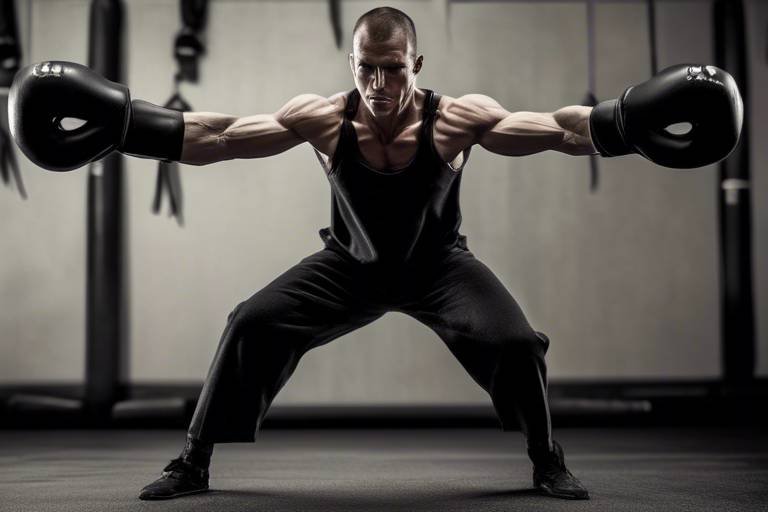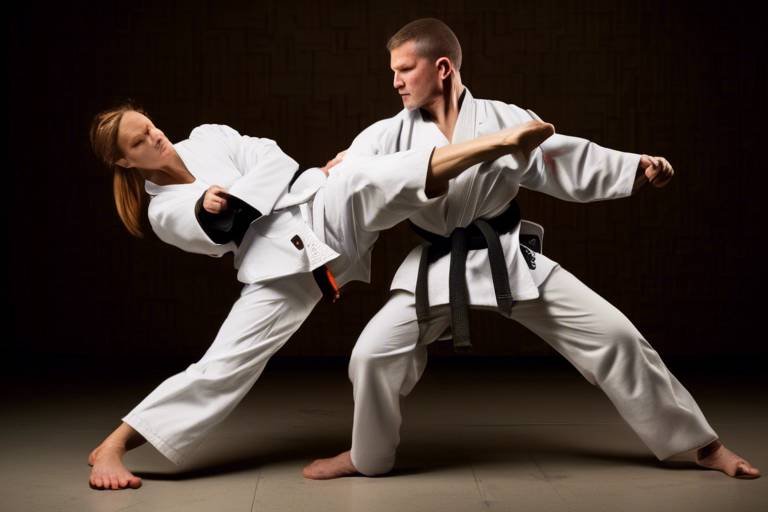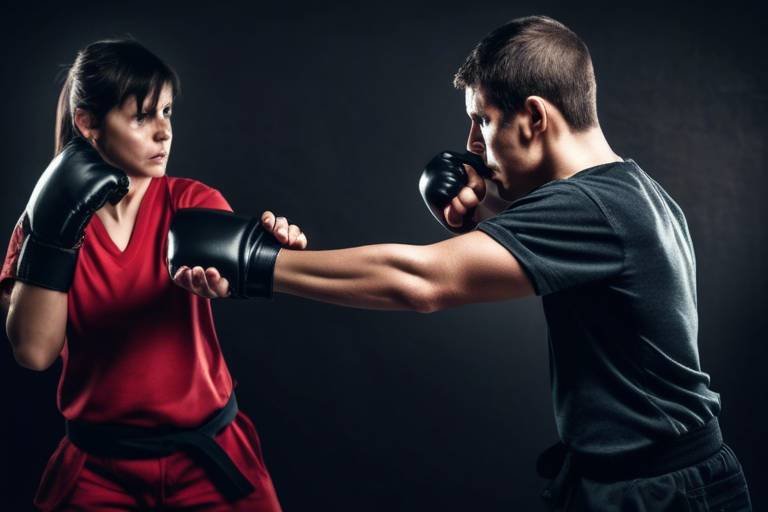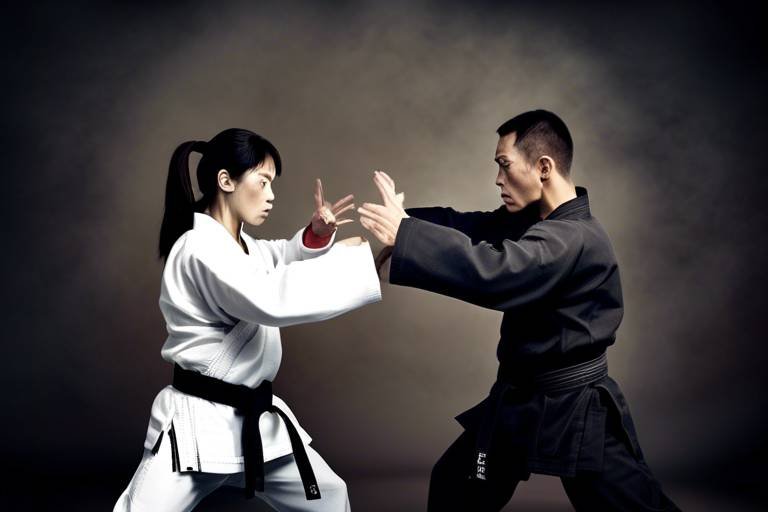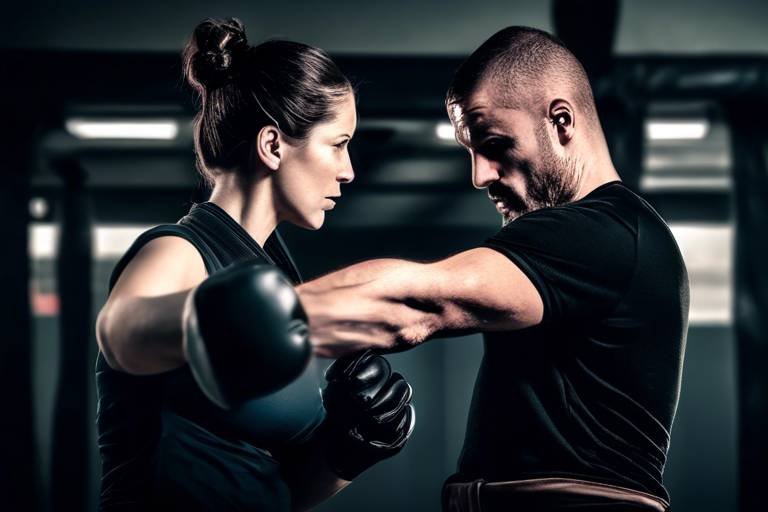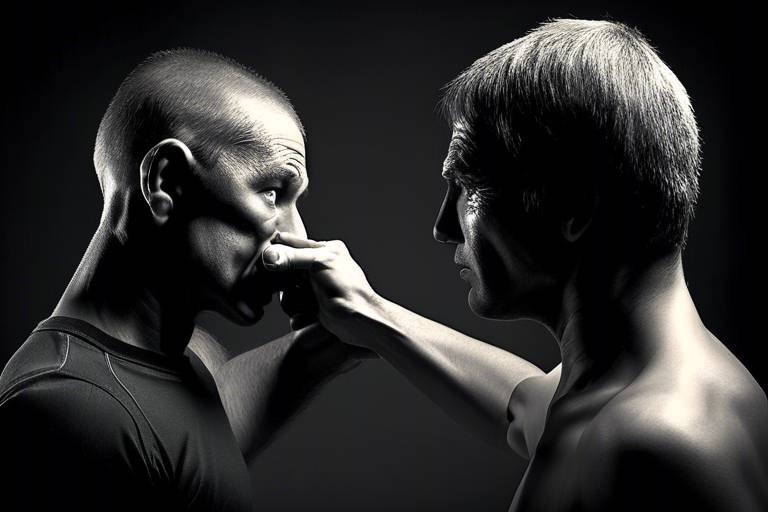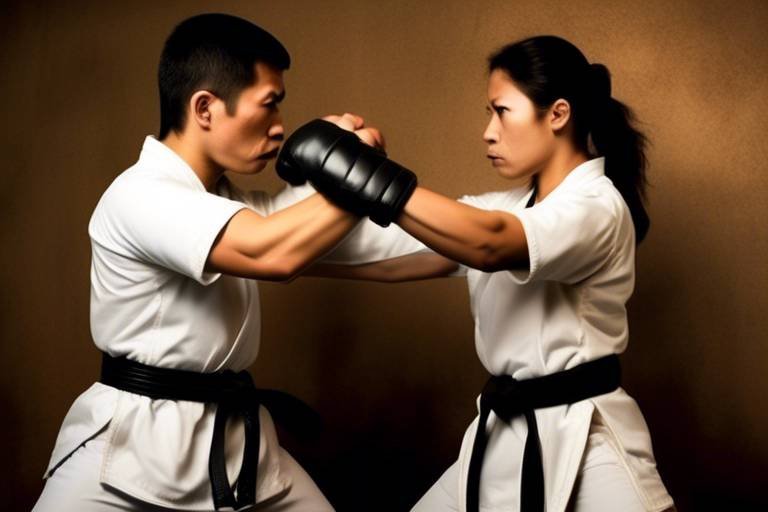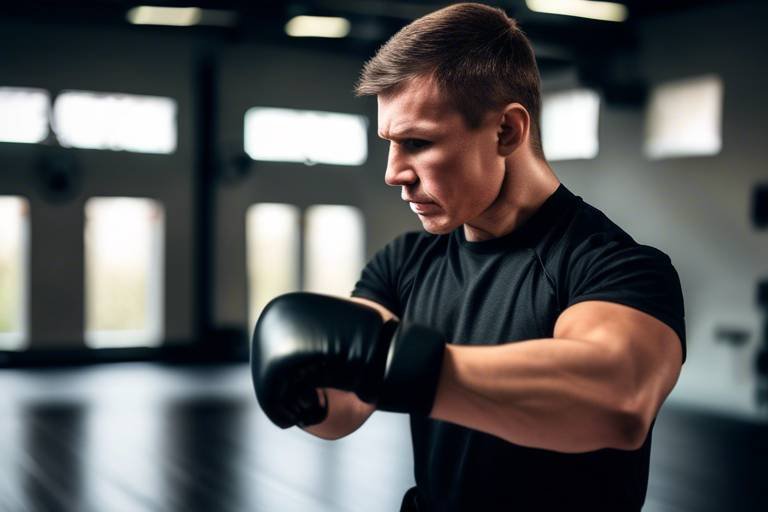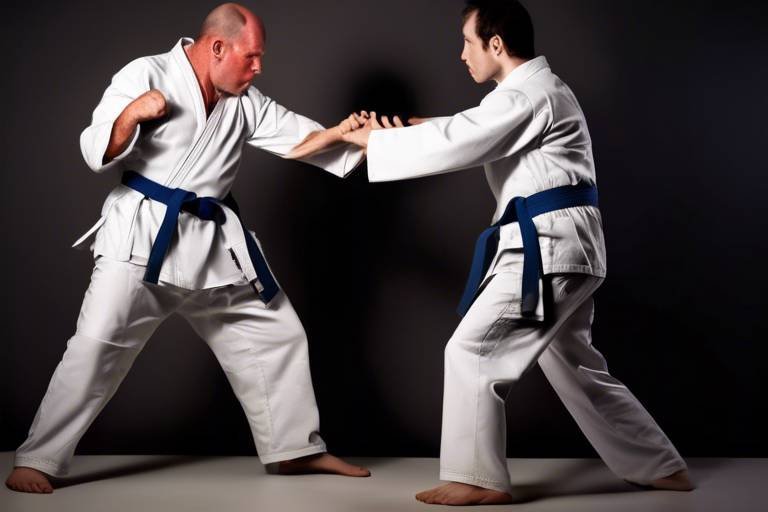Real Life Applications of Self-Defense Techniques - A Guide
This article explores various self-defense techniques and their practical applications in everyday life, emphasizing the importance of personal safety and empowerment through knowledge and training.
Self-defense encompasses a range of techniques aimed at protecting oneself from physical harm. It’s not just about fighting back; it’s about understanding the principles that govern self-defense and the legal aspects surrounding it. Knowing when and how to use these techniques can make a significant difference in a threatening situation. For instance, did you know that in many jurisdictions, you are allowed to use reasonable force to protect yourself? This means that understanding the law can empower you to act confidently, knowing you are within your rights to defend yourself. So, let’s dive deep into the essentials of self-defense and why it matters.
From basic strikes to advanced grappling, self-defense techniques are designed to equip individuals with the skills needed to respond effectively in threatening situations. These techniques range widely, and each has its unique application depending on the scenario. Whether you’re faced with an aggressor on the street or an unwanted advance at a social gathering, knowing how to react can be a game changer. Here are a few common techniques:
- Striking Techniques: Punches, kicks, and elbow strikes that can incapacitate an attacker.
- Grappling Techniques: Holds and locks that can control or subdue an assailant.
- Escape Techniques: Methods to break free from holds or grabs.
Striking techniques, such as punches and kicks, are fundamental in self-defense. They are often the first line of defense when confronted with an aggressor. The effectiveness of these techniques lies not just in their execution but also in the precision of targeting. For example, a well-placed punch to the nose can disorient an attacker, giving you a chance to escape. It’s crucial to practice these techniques safely and efficiently to maximize their impact. Remember, the goal is not to engage in a prolonged fight but to create an opportunity for escape.
Identifying effective target areas on an attacker can enhance self-defense effectiveness. Striking vulnerable spots can incapacitate an assailant quickly and safely. Common target areas include:
| Target Area | Effect |
|---|---|
| Nose | Disorientation and pain |
| Eyes | Temporary blindness |
| Throat | Difficulty breathing |
| Groin | Severe pain and incapacitation |
Your surroundings can be invaluable in a self-defense scenario. Objects such as bags, keys, or even a drink can be used to distract or deter an attacker. For instance, throwing your bag in one direction can create a diversion, allowing you to escape in the opposite direction. Additionally, understanding the terrain can provide a tactical advantage. A crowded area might offer more opportunities to evade, while an isolated space could be more dangerous. Always be aware of your environment and think creatively about how to use it to your advantage.
Grappling techniques are crucial for close encounters. When an attacker gets too close, knowing how to grapple can help you regain control. Techniques like joint locks and throws can be effective in subduing an aggressor without causing unnecessary harm. It’s essential to practice these techniques to develop muscle memory, ensuring that you can execute them under stress. Remember, the goal is to neutralize the threat and escape, not to engage in a prolonged struggle.
Situational awareness is vital for preventing confrontations. Staying alert and recognizing potential threats in everyday environments can significantly enhance your personal safety. It’s about being aware of your surroundings and trusting your instincts. For example, if something feels off about a situation—perhaps someone is following you or a group is acting suspiciously—it’s okay to remove yourself from that environment. Awareness is your first line of defense.
Understanding how to identify potential threats is essential for self-defense. Look for red flags such as:
- Unusual behavior from individuals around you.
- Being followed or approached by someone in an aggressive manner.
- Feeling uncomfortable in a particular environment.
By being vigilant, you can often spot trouble before it escalates, allowing you to take preventive measures.
Not every situation requires physical confrontation. Sometimes, the best self-defense is simply avoiding conflict altogether. Verbal de-escalation techniques can diffuse a tense encounter, promoting safety without resorting to violence. For instance, using a calm voice, maintaining non-threatening body language, and showing empathy can often calm an aggressor. Think of it like trying to extinguish a fire with water instead of gasoline; the right approach can prevent a small spark from turning into a raging blaze.
Q: Do I need to be trained to defend myself?
A: While formal training can be incredibly beneficial, basic knowledge of self-defense techniques and situational awareness can empower anyone to respond effectively in a threatening situation.
Q: What should I do if I feel threatened?
A: Trust your instincts. If you feel unsafe, try to remove yourself from the situation and seek help if necessary.
Q: Is it legal to use self-defense techniques?
A: Yes, in many jurisdictions, you are allowed to use reasonable force to defend yourself. However, it’s essential to understand the laws in your area.

Understanding Self-Defense
Self-defense is more than just a collection of physical techniques; it embodies the right to protect oneself from harm. In a world where unexpected situations can arise at any moment, understanding the principles of self-defense becomes essential for personal safety and empowerment. At its core, self-defense is about making informed decisions in high-pressure situations, allowing individuals to respond effectively when faced with potential threats.
Legally speaking, self-defense is often justified when an individual reasonably believes they are in imminent danger. However, it's crucial to know the laws in your specific region, as they can vary widely. For instance, some places allow for the use of reasonable force in self-defense, while others may impose strict limitations. Understanding these legal nuances not only protects you but also empowers you to act confidently and decisively when necessary.
Moreover, self-defense isn't solely about physical confrontation; it also encompasses mental preparedness and situational awareness. By being aware of your surroundings and recognizing potential threats, you can often avoid confrontations altogether. This proactive approach to personal safety is just as important as knowing how to physically defend yourself. Think of it like a chess game; the more you anticipate your opponent's moves, the better your chances of winning.
In this section, we will delve into the various techniques and strategies that make up the self-defense landscape. From striking techniques to grappling, and from understanding the legal implications to mastering situational awareness, the goal is to equip you with the knowledge and skills necessary to protect yourself effectively.
As we explore these topics, remember that self-defense is not about promoting violence but rather about ensuring safety and well-being. It’s about empowerment and confidence, transforming fear into strength. So, gear up and let’s take a closer look at the world of self-defense and how it can profoundly impact your life.

Common Self-Defense Techniques
When it comes to self-defense, having a repertoire of techniques at your disposal can make all the difference in a tense situation. These techniques are not just about physical prowess; they are about empowering yourself with the knowledge to protect your personal safety. Whether you're walking home late at night or simply want to feel more secure in your daily life, understanding these self-defense methods can provide you with the confidence you need. Let's dive into some of the most common self-defense techniques that everyone should consider learning.
One of the most fundamental aspects of self-defense is striking techniques. Striking involves using your fists, elbows, knees, and feet to fend off an attacker. Techniques such as punches and kicks can be incredibly effective when executed correctly. For instance, a well-placed jab to the face can disorient an assailant long enough for you to escape. But remember, the goal is not to engage in a prolonged fight; it’s about creating an opportunity to get away safely. Practice makes perfect, so consider enrolling in a self-defense class or martial arts training to refine your striking skills.
Striking techniques are the bread and butter of self-defense. They are straightforward yet powerful. The key to effective striking lies in understanding the mechanics of your body and how to deliver force efficiently. For example, a simple front kick can be a game-changer when aimed at an attacker's knee or groin. These target areas are not only vulnerable but can also incapacitate an assailant quickly, allowing you to escape. Remember, the element of surprise can be your best ally, so practice your strikes until they become second nature.
When it comes to self-defense, knowing where to strike can significantly enhance your effectiveness. Here are some effective target areas you might want to focus on:
- Eyes: A quick jab or poke can blind an attacker temporarily.
- Nose: A strong punch or upward strike can cause pain and disorientation.
- Throat: A targeted strike can disrupt breathing and incapacitate.
- Groin: Kicking or striking this area can incapacitate an attacker effectively.
- Knees: A kick to the knee can destabilize an assailant.
By targeting these areas, you can increase your chances of escaping an attack unharmed. However, always remember that the primary goal is to get away, not to engage in a fight.
Your surroundings can be your greatest ally during a self-defense situation. Whether it's using a nearby object as a shield or leveraging the terrain to your advantage, being aware of your environment can provide you with creative options. For instance, if you find yourself cornered, look for items such as a bag, umbrella, or even a stick that can be used to create distance between you and your attacker. Additionally, understanding the layout of your environment—like knowing where the exits are—can help you escape more effectively.
While striking techniques are vital, grappling skills are equally important, especially in close encounters. Grappling techniques involve holds and maneuvers that can help you control an attacker or escape from a tight situation. Techniques such as joint locks, throws, and escapes can be incredibly useful when an assailant gets too close for comfort. Learning how to maneuver on the ground can also be beneficial if you find yourself taken down. Remember, even if you're on the ground, there are ways to regain control and escape.
In summary, mastering common self-defense techniques is about more than just physical ability; it’s about building confidence and awareness. By understanding striking techniques, effective target areas, and how to use your environment, as well as grappling skills, you can empower yourself to handle dangerous situations. So, why not take the first step today? Consider enrolling in a self-defense class and equip yourself with the tools you need to feel safe and secure in your everyday life.

Striking Techniques
Striking techniques are the backbone of self-defense, acting as your first line of defense when faced with an aggressor. These techniques include various forms of punches, kicks, and open-hand strikes that can quickly incapacitate an attacker. But it’s not just about throwing a punch; it’s about knowing **how** and **when** to strike effectively. Imagine being faced with a situation where you need to defend yourself—having the right striking techniques under your belt can make all the difference. It's like having a trusty tool in your toolbox; you need to know how to use it to fix the problem at hand.
To effectively execute striking techniques, one must focus on precision, speed, and power. Think of a well-timed punch as a coiled spring—when released, it should deliver a powerful impact. The key to mastering these techniques lies in practice and understanding your body mechanics. For example, when delivering a punch, you should rotate your hips and shoulders to generate more force, rather than just relying on your arms. This way, your strikes become more effective and less likely to leave you vulnerable after the hit.
Here’s a quick breakdown of some common striking techniques:
- Punches: These include jabs, crosses, hooks, and uppercuts. Each serves a different purpose and can be used in various scenarios.
- Kicks: Front kicks, roundhouse kicks, and side kicks can create distance between you and your attacker, allowing you to escape or prepare for another strike.
- Open-hand strikes: Techniques like palm strikes and knife-hand strikes can be particularly effective in close quarters.
When practicing these techniques, it's crucial to focus on target areas. Striking vulnerable spots on an assailant can incapacitate them quickly, giving you the chance to escape. Common target areas include:
| Target Area | Effect |
|---|---|
| Nose | Causes pain and disorientation |
| Throat | Can incapacitate and restrict breathing |
| Eyes | Temporarily blinds and distracts |
| Solar Plexus | Knocks the wind out of the attacker |
| Knees | Can immobilize an attacker |
Incorporating striking techniques into your self-defense repertoire not only enhances your physical capabilities but also boosts your confidence. It’s empowering to know that you have the skills to defend yourself in a potentially dangerous situation. Remember, self-defense isn’t just about being able to fight; it’s about being prepared and having the mental fortitude to act when necessary. So, practice these techniques regularly, and you'll find that they become second nature, making you feel more secure in your day-to-day life.
1. How can I learn striking techniques effectively?
To learn striking techniques effectively, consider enrolling in a self-defense class or martial arts program. Practice regularly, and focus on both technique and physical conditioning.
2. Are striking techniques safe to practice?
Yes, striking techniques can be practiced safely with the right training and under the supervision of a qualified instructor. Always use protective gear when sparring.
3. Can I use striking techniques in real-life situations?
While striking techniques are designed for self-defense, it’s essential to assess each situation carefully. The goal is to escape safely, not to engage in combat.
4. What should I do if I feel threatened?
If you feel threatened, trust your instincts. Use your situational awareness to assess the situation and, if necessary, use your self-defense skills to protect yourself.

Effective Target Areas
In the realm of self-defense, knowing where to strike can be the difference between escape and harm. It's not just about throwing punches or kicks; it's about strategically targeting vulnerable areas on an assailant's body. By focusing on these effective target areas, you can maximize your chances of incapacitating an attacker quickly and safely. Imagine you're in a situation where every second counts—having this knowledge can empower you to act decisively.
Some of the most effective target areas include:
- Eyes: A swift jab to the eyes can disorient an attacker and give you precious moments to escape.
- Nose: A well-placed strike to the nose can cause pain and bleeding, potentially incapacitating the assailant.
- Throat: Targeting the throat can disrupt breathing, making it a critical point in self-defense.
- Solar Plexus: A strike to the solar plexus can knock the wind out of someone, leaving them momentarily stunned.
- Groin: A kick to the groin is often effective due to the pain it causes, allowing for a quick escape.
These areas are not only effective but also relatively easy to target, even for those who may not have extensive training. The key is to remain calm and focused, aiming for these spots with precision. Remember, self-defense is about survival and empowerment, and knowing where to strike can make all the difference.
It's also important to consider your environment when thinking about effective target areas. For instance, if you're in a crowded place, a quick jab to the eyes or a knee to the groin can be executed discreetly, allowing you to escape without drawing too much attention. Being aware of your surroundings can help you decide the best course of action when confronted with a threat.
In addition to physical strikes, understanding the anatomy of these target areas can enhance your effectiveness. For example, the eyes and throat are not just vulnerable; they are also areas that, when struck, can lead to immediate incapacitation. This is crucial in a self-defense scenario where your goal is to create an opportunity to escape.
In summary, effective target areas are essential knowledge for anyone interested in self-defense. By focusing your energy on these spots, you can increase your chances of successfully defending yourself in a dangerous situation. Remember, the goal is not to engage in a fight but to create a chance for you to get away safely.
Q: What should I do if I can't remember the target areas during a confrontation?
A: In high-stress situations, it's natural to forget details. Focus on your instincts and aim for the most accessible areas—eyes, nose, throat, and groin are often the easiest to remember.
Q: Are there any legal considerations when using self-defense techniques?
A: Yes, laws vary by location. It's important to understand the legal implications of self-defense in your area, including what constitutes reasonable force.
Q: Can self-defense training help even if I never have to use it?
A: Absolutely! Self-defense training builds confidence, awareness, and physical fitness, all of which can enhance your overall safety in everyday life.

Using Your Environment
When it comes to self-defense, many people think that the only tools at their disposal are their fists or feet. However, one of the most powerful assets you have is your environment. Just like a skilled chess player uses the board to their advantage, you can utilize your surroundings to enhance your safety and improve your chances of escaping a dangerous situation. Imagine walking down a street and suddenly feeling threatened; the objects around you can become your best friends in that moment.
First, consider the various objects that may be within reach. Everyday items like keys, a pen, or even a bag can be transformed into effective self-defense tools. For instance, if you find yourself in a tight spot, holding your keys between your fingers can create an improvised striking tool. Similarly, a pen can serve as a means to jab at an assailant. The key here is to remain calm and think creatively about how to use what’s around you. Remember, the goal is to create an opportunity to escape rather than engage in a prolonged confrontation.
Moreover, the terrain plays a crucial role in self-defense. Are you on a crowded sidewalk, or are you in an open park? In a crowded area, you can use the presence of other people to your advantage; simply moving towards a group can dissuade an attacker. On the other hand, if you’re in an open space, try to position yourself in a way that gives you a clear escape route. Always be aware of your surroundings, and look for exits or places to hide if necessary.
Additionally, consider how you can use barriers to protect yourself. For example, if an attacker approaches, stepping behind a car or a bench can provide you a moment to gather your thoughts and plan your next move. This not only creates physical distance but also puts an obstacle between you and the threat. In situations where you can’t escape, using barriers can help you defend yourself until help arrives or until you can safely get away.
In summary, the environment is not just a backdrop; it’s a dynamic part of your self-defense strategy. By being aware of your surroundings and thinking on your feet, you can turn everyday objects and spaces into powerful allies. The next time you step outside, take a moment to survey your environment. What could you use in a pinch? How can you position yourself for safety? By asking these questions, you empower yourself to respond effectively in potentially dangerous situations.
- What should I do if I feel threatened in public?
Stay calm, assess your surroundings, and look for exits or safe places to go. Use any available objects as improvised tools for self-defense if necessary. - Can I use everyday items for self-defense?
Absolutely! Items like keys, pens, and bags can be effective in self-defense situations when used creatively. - How can I improve my situational awareness?
Practice being mindful of your environment, observe people around you, and trust your instincts. Regularly assess potential threats in your surroundings. - What are de-escalation techniques?
These are verbal strategies aimed at calming a tense situation without resorting to physical confrontation. Techniques include using a calm tone, showing understanding, and finding common ground.

Grappling and Ground Defense
When it comes to self-defense, grappling and ground defense techniques play a pivotal role, especially in situations where an attacker gets too close for comfort. Imagine this: you’re at a party, and someone suddenly becomes aggressive. You don’t have the space to throw a punch, and running away isn’t an option. This is where grappling comes into play. It’s all about controlling the situation when things get physical. By mastering these techniques, you empower yourself to handle confrontations effectively and safely.
Grappling techniques involve various holds, locks, and throws that can help you manage an assailant’s movements. For instance, a simple but effective technique is the bear hug escape. If someone grabs you from behind, instead of panicking, you can drop your weight and twist your body while using your elbows to create space. This not only breaks their grip but also allows you to reposition yourself to either escape or counter-attack. Remember, the goal is to create distance and regain control.
Another essential aspect of grappling is ground defense. If you find yourself on the ground, whether due to a fall or being tackled, knowing how to defend yourself can be the difference between safety and danger. Techniques like the guard position and mount position allow you to control your opponent while minimizing your vulnerability. For example, from the guard position, you can use your legs to keep an assailant at bay while looking for opportunities to escape or strike.
To illustrate the importance of grappling and ground defense, consider the following table that outlines some common techniques and their applications:
| Technique | Description | Application |
|---|---|---|
| Bear Hug Escape | Breaking free from a rear bear hug | Effective in close encounters where escape is necessary |
| Guard Position | Using your legs to control an opponent from the ground | Helps maintain distance and prepare for counter-attacks |
| Mount Position | Positioning yourself on top of an opponent | Allows for control and striking opportunities |
It’s also vital to practice these techniques regularly. Just like learning to ride a bike, the more you practice grappling, the more instinctive it becomes. Training with a partner can help simulate real-life scenarios, which is crucial for developing muscle memory and confidence. Plus, it’s a great way to build rapport with fellow trainees while learning from each other’s experiences.
In conclusion, grappling and ground defense techniques are indispensable tools in the self-defense arsenal. They not only provide practical methods for handling close encounters but also foster a sense of empowerment. Remember, the aim is not just to fight back but to create opportunities for escape and safety. By incorporating these techniques into your self-defense training, you prepare yourself for a variety of situations, ensuring that you can respond effectively, no matter what comes your way.
- What are the most effective self-defense techniques for beginners? Basic striking techniques, bear hug escapes, and learning to maintain distance are great starting points.
- Can I learn self-defense on my own? While self-defense can be practiced alone, training with a partner or instructor is highly recommended for effective learning.
- How often should I practice self-defense techniques? Regular practice is key; aim for at least once a week to maintain your skills and confidence.
- Is self-defense training suitable for everyone? Yes! Self-defense training is beneficial for people of all ages and fitness levels.

Situational Awareness
Situational awareness is like having a superpower in your daily life. It’s the ability to be aware of your surroundings and understand what’s happening around you. Imagine walking through a busy street, and instead of being glued to your phone, you’re scanning the area for anything unusual. This skill can be a game-changer when it comes to personal safety. It’s not just about being paranoid; it’s about being prepared. By honing your situational awareness, you can identify potential threats before they escalate, giving you the upper hand in any situation.
One of the key aspects of situational awareness is recognizing your environment. This means understanding the places you frequent, whether it’s your neighborhood, workplace, or local park. Are there dark alleys or poorly lit areas? Are there people who seem out of place? By familiarizing yourself with these details, you can make informed decisions about where to go and when to avoid certain areas. It’s like being a detective in your own life, piecing together clues to keep yourself safe.
Another important element is paying attention to people. Not everyone has good intentions, and sometimes, you can sense trouble before it even happens. Look for red flags such as someone who is acting aggressively or is overly focused on you. Trust your gut feeling; if something feels off, it probably is. This doesn’t mean you should be suspicious of everyone, but rather that you should be aware of the dynamics around you. It’s about reading the room and understanding social cues, which can often indicate potential threats.
To enhance your situational awareness, consider practicing the 5-Second Rule. This involves taking a brief moment every five seconds to scan your environment. Ask yourself questions like:
- What do I see?
- What do I hear?
- What do I feel?
By doing this regularly, you train your brain to be more observant, making it easier to spot anything unusual. It’s like tuning an instrument; the more you practice, the sharper your senses become.
In addition to being aware of your surroundings, it’s crucial to have an escape plan. Think of it as a mental map of your environment. If you’re in a crowded place, identify exits and potential safe spots. If a situation turns hostile, knowing where to go can be the difference between safety and danger. This mental preparation is a proactive approach to personal safety.
Lastly, remember that situational awareness isn’t just about physical threats. It also encompasses emotional and psychological safety. Be aware of how certain situations or people make you feel. If you’re in a conversation that feels uncomfortable or threatening, don’t hesitate to remove yourself from it. Your emotional well-being is just as important as your physical safety.
Q: What is situational awareness?
A: Situational awareness is the ability to perceive and understand your environment, recognizing potential threats and making informed decisions to ensure personal safety.
Q: How can I improve my situational awareness?
A: You can improve situational awareness by regularly scanning your environment, being mindful of your surroundings, and practicing the 5-Second Rule to enhance your observational skills.
Q: Is situational awareness only for self-defense?
A: No, situational awareness is beneficial in many areas of life, including avoiding accidents, improving decision-making, and enhancing overall personal safety.
Q: Can situational awareness help in non-threatening situations?
A: Absolutely! Being aware of your surroundings can help you navigate social situations better, avoid conflicts, and enhance your overall quality of life.

Recognizing Threats
In the world we live in today, being able to recognize potential threats is more crucial than ever. Imagine walking down the street, and you suddenly notice someone acting suspiciously. What do you do? The ability to identify these red flags can mean the difference between staying safe and becoming a victim. It's not just about being paranoid; it's about being aware and prepared.
To effectively recognize threats, you need to develop a keen sense of situational awareness. This means being conscious of your surroundings and understanding the behaviors of people around you. Look for signs that might indicate a person's intentions. For example, if someone is lingering too long in one spot, watching others without engaging, or displaying aggressive body language, these could be warning signs. It’s like being a detective—always on the lookout for clues that something isn’t quite right.
Additionally, consider the environment you’re in. Certain places can increase the likelihood of encountering threats, such as poorly lit areas or locations that are isolated. It’s essential to be mindful of these factors and to trust your instincts. If something feels off, it probably is. Your gut feelings are often your first line of defense.
Here are some common indicators to help you recognize potential threats:
- Unusual Behavior: Look for people who are acting out of the ordinary, such as pacing back and forth or making erratic movements.
- Body Language: Closed-off body language, like crossed arms or avoiding eye contact, can indicate discomfort or aggression.
- Excessive Attention: If someone seems overly focused on you or your belongings, it could be a sign of ill intent.
It's also important to remember that threats can come in various forms. Not all threats are physical; some can be verbal or psychological. For instance, if someone is verbally aggressive or tries to intimidate you, it's essential to recognize that as a potential threat. In these situations, maintaining your composure and being aware of your exit options can be vital.
Ultimately, recognizing threats is about being proactive rather than reactive. By training yourself to notice these signs, you increase your chances of avoiding dangerous situations altogether. Think of it as honing a skill—like learning to ride a bike. At first, it may feel awkward, but with practice, it becomes second nature. So, whether you’re walking home late at night or simply navigating through a crowded area, stay alert, trust your instincts, and remember that your safety is always a priority.
1. How can I improve my situational awareness?
To improve your situational awareness, practice being mindful of your surroundings. Take mental notes of the people around you, their behaviors, and any changes in your environment. Regularly assess exit routes and potential hazards.
2. What should I do if I recognize a threat?
If you recognize a threat, trust your instincts. If possible, remove yourself from the situation and seek help if necessary. Stay calm and avoid escalating the situation unless absolutely necessary.
3. Are there specific self-defense techniques for recognizing threats?
While self-defense techniques focus more on physical confrontations, many self-defense classes also teach situational awareness and how to recognize potential threats. Consider taking a class that covers both aspects.

De-escalation Techniques
When faced with a potentially volatile situation, the ability to de-escalate can be your best defense. De-escalation techniques are all about reducing tension and preventing a confrontation from escalating into a physical altercation. Imagine walking into a room where two people are arguing heatedly; your instinct might be to intervene, but how you choose to do so can make all the difference. Instead of jumping in aggressively, consider using your words and body language to calm the situation.
One effective way to de-escalate is through active listening. This means not only hearing what the other person is saying but also showing that you understand their feelings. You might say, “I can see that you’re really upset about this,” which acknowledges their emotions and can help lower their defenses. It’s like pouring water on a fire; the more you validate their feelings, the less likely they are to lash out. Remember, people often escalate conflicts when they feel unheard or dismissed, so giving them that space to express themselves can be crucial.
Another technique involves maintaining a non-threatening posture. Your body language can speak volumes, so keep your hands visible and avoid crossing your arms, which can appear defensive. Instead, try to adopt an open stance, perhaps even slightly leaning forward to show you’re engaged and willing to communicate. This approach is akin to being a bridge rather than a wall; you want to connect rather than block any potential understanding.
In some situations, asking open-ended questions can also help. Questions like, “What do you think would be a fair solution?” can shift the focus from confrontation to collaboration. This not only empowers the other person but also encourages problem-solving rather than fighting. It’s like turning a boxing match into a discussion; instead of throwing punches, you’re throwing ideas around.
It’s also important to be aware of your own emotional state. If you’re feeling agitated or defensive, it can be challenging to de-escalate a situation effectively. Take a moment to breathe and collect your thoughts before engaging. Sometimes, stepping back physically and mentally can provide clarity and reduce the tension in the air.
In summary, de-escalation techniques are invaluable tools in your self-defense arsenal. They allow you to navigate potentially dangerous situations without resorting to violence. By practicing active listening, maintaining an open posture, asking the right questions, and managing your emotional state, you can effectively diffuse conflicts and promote safety. Remember, the goal is to create a space where dialogue can flourish instead of fists, and where understanding can replace aggression.
- What are de-escalation techniques? De-escalation techniques are methods used to reduce tension and prevent conflicts from escalating into violence.
- Why is situational awareness important in self-defense? Situational awareness helps individuals recognize potential threats and avoid confrontations before they escalate.
- Can verbal de-escalation be effective in all situations? While verbal de-escalation can be effective in many situations, it may not be appropriate in all cases, especially if there is an immediate physical threat.
- How can I practice de-escalation techniques? You can practice by role-playing scenarios with friends or family, focusing on active listening and maintaining calm body language.
Frequently Asked Questions
- What is self-defense?
Self-defense refers to a range of techniques aimed at protecting oneself from physical harm. It's not just about fighting back; it's about understanding how to avoid dangerous situations and knowing what to do if you find yourself in one.
- Are self-defense techniques legal?
Yes, self-defense techniques are legal, but the application can vary by jurisdiction. It's crucial to understand the laws in your area regarding self-defense to ensure that you're acting within your rights and using appropriate levels of force.
- What are some common self-defense techniques?
Common self-defense techniques include striking techniques like punches and kicks, grappling moves such as holds and escapes, and utilizing your environment to gain an advantage. Each technique serves a different purpose depending on the situation.
- How can I improve my situational awareness?
Improving situational awareness involves being mindful of your surroundings, recognizing potential threats, and trusting your instincts. Regularly practicing observation skills and staying alert can help you spot red flags before they escalate into dangerous situations.
- What should I do if I feel threatened?
If you feel threatened, it's essential to stay calm and assess the situation. If possible, remove yourself from the environment. If confrontation is unavoidable, use verbal de-escalation techniques to diffuse the situation before resorting to physical self-defense.
- Can I learn self-defense techniques on my own?
While it's possible to learn some self-defense techniques through online resources or videos, it's highly recommended to seek professional training. An instructor can provide valuable feedback, ensure you practice safely, and help you build confidence in your skills.
- How effective are striking techniques in self-defense?
Striking techniques can be highly effective when executed properly. They allow you to create distance from an attacker and escape a threatening situation. However, it’s essential to target vulnerable areas and practice these techniques regularly for maximum effectiveness.
- What role does the environment play in self-defense?
Your environment can be a powerful ally in self-defense. Objects around you can be used as shields or tools for defense. Understanding how to leverage your surroundings can significantly enhance your ability to protect yourself in a confrontational situation.
- Are there self-defense classes for beginners?
Absolutely! Many self-defense classes cater to beginners, focusing on fundamental techniques and building confidence. These classes provide a supportive environment to learn at your own pace, making them ideal for anyone interested in personal safety.


